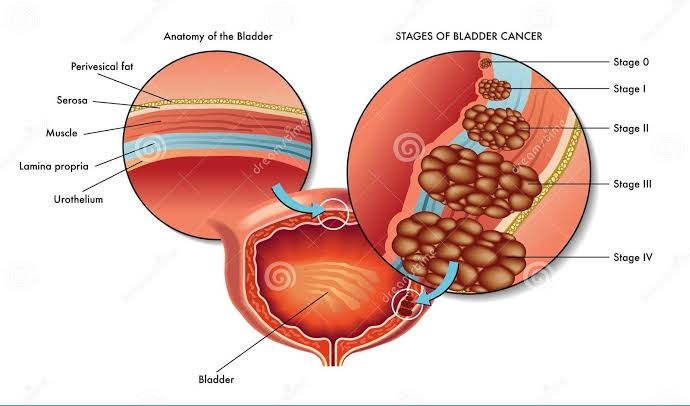What is Bladder Cancer?
Bladder cancer is the second most common cancer among cancers that occur throughout the urinary tract, starting from the kidneys. Approximately two-thirds of bladder cancers are formations that do not follow a fatal course but tend to recur, while one-third are formations with a poor course that have the potential to spread (metastasize) to muscle tissue and then to the rest of the body. Bladder cancer occurs more in men than in women. And the disease usually occurs in people in the adult age group.
What are The Types of Bladder Cancer?
Bladder cancer is divided into three and classified according to the severity of the cancer.
-
Transitional Cell Carcinoma:
Transitional cell carcinoma, also called urothelial carcinoma, is a type of cancer that begins in the transitional cells in the inner lining of the bladder wall. Approximately 90% of all bladder cancers are transient. In this type of cancer, abnormal cells spread from the inner lining to other layers deep within your bladder or through your bladder wall to the fatty tissues surrounding your bladder.
-
Squamous Cell Carcinoma:
Squamous cells are thin, flat cells lining the inside of your bladder.
This Squamous cell carcinoma accounts for approximately 5% of bladder cancers. And it usually occurs in people who experience long-term bladder inflammation or irritation.
-
Adenocarcinoma:
Adenocarcinoma cancers are cancers of the glands that line organs and tissues, including the bladder. This is a very rare type of bladder cancer. And it accounts for 1% to 2% of all bladder cancers. This spread is called metastasis.
What are The Factors That Cause Bladder Cancer?
-
To Smoke:
Smoking cigarettes, cigars or pipes can increase the risk of bladder cancer by causing harmful chemicals to accumulate in the urine.
When you smoke, your body processes the chemicals in the smoke and excretes some of them through urine. These harmful chemicals can damage the lining of your bladder, which can increase your risk of cancer.
-
Increasing Age:
The risk of bladder cancer increases as you get older. Although it can occur at any age, most people diagnosed with bladder cancer are older than 55.
-
Being a Man:
Men are more likely than women to develop bladder cancer.
Exposure to certain chemicals. Your kidneys play an important role in filtering harmful chemicals from your bloodstream and transporting them to your bladder. Therefore, it is thought that being around certain chemicals may increase the risk of bladder cancer. Chemicals linked to bladder cancer risk include arsenic and chemicals used in the production of dyes, rubber, leather, textiles and dye products.
-
Previous Cancer Treatment:
Treatment with the anti-cancer drug cyclophosphamide increases the risk of bladder cancer. People who received radiation therapy to the pelvis for a previous cancer have a higher risk of developing bladder cancer.
-
Chronic Bladder Inflammation:
Chronic or recurrent urinary tract infections or inflammations (cystitis) that may occur with long-term use of a urinary catheter may increase the risk of squamous cell bladder cancer.
-
Personal or Family History of Cancer:
If you’ve had bladder cancer, the cancer is more likely to reoccur. If a first-degree relative (parent, sibling, or child) has a history of bladder cancer, you may be at increased risk of the disease, although it is rare for bladder cancer to run in families.
A family history of Lynch syndrome, also known as hereditary nonpolyposis colorectal cancer (HNPCC), may increase the risk of cancer in the urinary tract as well as the colon, uterus, ovaries, and other organs.
What are The Symptoms Of Bladder Cancer?
The Most Common Symptoms of Bladder Cancer Are:
-
Bleeding in Urine:
Bladder cancer can cause urinary changes. Blood in the urine (hematuria) is the most common symptom. Urine becomes red or pinkish in color.
In addition, burning, pain or difficulty during urination may also be among the symptoms of bladder cancer. It is important to pay attention to such changes and consult a urologist immediately.
-
Frequent Urination:
Some people with bladder cancer experience frequent urination. There may be a need to go to the toilet more often than usual or a sudden feeling of urgency. The frequency of urination may increase, especially at night. If you experience this condition repeatedly or feel an unusually frequent need to urinate, it is important to consult a urologist.
-
Urinary Tract Infections:
Recurrent urinary tract infections may also occur in people with bladder cancer. Cancerous tissue in the urinary tract becomes prone to infection, increasing the risk of infection. Frequent urination, burning sensation and blood in the urine may occur due to urinary tract infections. If you experience recurrent urinary tract infections, it is important to see a urologist.
-
Abdominal or Back Pain:
As bladder cancer progresses, pain may be felt in the abdomen or back area. These pains usually occur in the advanced stages of cancer. As cancer spreads to surrounding tissues, it can affect nerve endings and cause pain. If you suspect persistent or severe abdominal or back pain, it is important to consult a urologist.
-
Loss of Appetite and Weight Loss:
Loss of appetite and weight loss may occur in people with bladder cancer. Cancer can deplete the body’s energy resources, leading to loss of appetite and weight loss. If you are experiencing significant weight loss, it is important to consult a specialist.
-
Fatigue and Weakness:
Bladder cancer can deplete the body’s energy resources, creating a feeling of fatigue and weakness. If you feel constantly tired and notice a significant decrease in your energy level, it is important to consult a specialist.
-
Bone Pains:
When bladder cancer progresses, cancer cells can spread to the bones and cause bone pain. Bone pain may occur especially in advanced stage cancers. If you are experiencing persistent or severe bone pain, it is important to consult a specialist.
What are The Stages of Bladder Cancer?
After bladder cancer is diagnosed, it must be staged with the system called TNM and its spread must be determined. In this way, the treatment plan to be applied is created.
The stages are as follows:
-
T (Tumor):
It measures how far the main tumor has developed in the bladder and whether it has spread to nearby tissues.
-
N (Lymph Nodes):
Lymph nodes are groups that act as a shield against diseases. It is checked to see if the cancer has spread to the lymph nodes in the bladder wall.
-
M (Metastasized):
It determines whether the disease has spread from the bladder area to other parts of the body or lymph nodes.
Within the framework of the T, N, M classification, the doctor gives information about the stage of bladder cancer. There are stages from 0 to IV.
These stages are as follows:
-
Stage 0:
Cancer develops only in the center of the bladder. It has not spread to the bladder wall and muscles.
It is a superficial cancer of the bladder and does not involve lymph nodes or spread to other organs.
-
Stage I:
Cancer has grown in the inner lining of the bladder. However, there is no growth in the muscle of the bladder wall. It has not yet spread to other tissues and organs.
-
Stage II:
It is the stage in which cancer progresses from the connective tissue of the bladder to the muscle layer, although it does not metastasize to any organ.
-
Stage III:
The cancer is now in the fatty tissue layer surrounding the bladder. It can also be found in the prostate, uterus and vagina. However, spread to organs distant from the bladder was not detected.
-
Stage IV:
This stage may refer to any of the following:
- The cancer has spread to the pelvic or abdominal wall. However, no involvement is yet seen in the lymph nodes or distant organs of the bladder.
- The cancer has spread to nearby lymph nodes. But it did not metastasize to distant organs.
- The cancer has metastasized to distant organs and tissues of the body, such as lymph nodes, bones, liver, and lungs.
What are The Bladder Cancer Diagnosis Methods?
Urine Tests Applied to Diagnose Bladder Cancer are as follows:
-
TIT:
Urine tests have an important place in diagnosis. The presence of blood cells (erythrocytes) in the urine in a complete urinalysis should reveal the suspicion of tumor.
-
Urine Cytology (Examination of a Urine Sample):
If there are no suspicious areas within the bladder, a sample of your urine is analyzed under a microscope to check for cancer cells in a procedure called urine cytology.
Even if there is no visible cancer, there may be cancer in the bladder. Some bladder cancers called CIS (carcinoma in situ) do not cause a mass in the bladder. It appears as a velvety structure inside the urinary bladder.
Urine cytology is a method whose sensitivity is low in low-grade tumors and at most 80% in high-grade tumors.
-
Urine Examinations:
There are some tests used in diagnosis today. Among these, BTA stat and NMP22 are the tests used in our country. However, their sensitivity is low for small tumors. Others are ImmunoCyst and UroVision DNA FISH.
Imaging Tests Used in the Diagnosis of Bladder Cancer are as follows:
-
Ultrasonography (USG):
Ultrasound, which does not require the application of contrast material, easily detects bladder tumors larger than 5 mm. It can also help find out if the kidneys or ureters are blocked. Ultrasound can also be used to determine the size of bladder cancer and whether it has spread to nearby organs or tissues.
-
Computed Tomography (CT Urogram):
It can provide information about the size, shape and location of any tumors in the urinary tract, including the bladder. It can also help show enlarged lymph nodes that may contain cancer, as well as other organs in the abdomen and pelvis. Sometimes a contrast agent is given to the patient orally or intravenously to obtain a more detailed image. Those who are allergic to iodine or other substances should inform their doctor beforehand.
-
Intravenous Pyelogram (IVP):
This method, which was used in the past to determine abnormalities in the bladder and urinary system, has been replaced by new methods that provide better information.
-
Retrograde Pyelogram:
It is a procedure similar to the intravenous pyalogram procedure. The contrast material used is injected directly into the urinary system using cystoscopy, not intravenously. The retrograde pyelogram procedure is used to find out what is causing the blockage in the normal flow of urine. It can also help diagnose cancer on the lining of the ureter or kidney.
-
MRI (Magnetic Resonance):
It can be used to measure the depth and size of a bladder tumor and to visualize the lymph to which the cancer has spread. To get a detailed image of the tumor and its effects, the patient must be given contrast material.
-
PET CT Scan:
A small amount of radioactive material is injected into the patient’s body. Since this radioactive substance is absorbed by cancerous cells that tend to use energy, it is visualized where the cancer has spread in the body. PET CT is not considered standard imaging for bladder cancer. It may have a potential role in the evaluation of metastatic bladder cancer.
-
Chest X-Ray:
It can be used to determine whether bladder cancer has spread to the lungs. If a chest CT scan has been performed, a chest X-ray is not needed.
-
Cystoscopy (Using a Device to Examine the Inside of Your Bladder):
Cystoscope is an instrument with a camera and 8-10 times magnification power that allows visual entry through the urethra. With this, the entire urethra and bladder inner mucosa can be seen with direct vision. It is the best, most valuable and easiest diagnostic method. Flexible cystoscopy is a simple but very valuable diagnostic method that can be performed even with local anesthesia.
-
Bladder Cancer Biopsy (Removing a Tissue Sample for Testing):
During cystoscopy, a biopsy is taken from the suspicious area. This procedure is sometimes called transurethral resection of bladder tumor (TURBT).
How is Bladder Cancer Treated?
Bladder cancer treatment varies depending on the severity and stage of the disease, and the process is planned by the doctor.
Bladder Cancer Surgery:
Surgeries used in the treatment of bladder cancer are as follows:
-
Transurethral Resection of Bladder Cancer (TUR-Bladder Surgery):
TUR bladder surgery or closed bladder tumor surgery is the process of removing bladder cancer by entering the urethra with a special tool, cutting it out. Electric current is passed through a half-moon-shaped wire at the tip of the tool. With this ring, the cancer in the bladder is cut into small particles. These tumor pieces are then removed from the bladder.
-
Bladder Cancer Treatment with Radical Cystectomy:
It is a surgical method in which the entire bladder and nearby tissues and organs are removed along with the tumor.
In radical cystectomy surgery, in addition to the bladder, the prostate and seminal vesicles of men, and in necessary patients, the entire urinary tract are removed.
In women, in the classical definition, all or part of the uterus, fallopian tubes, ovaries and uterus are removed. However, removal of the bladder within safe limits while leaving the gynecological organs in place has also been practiced in recent years.
In both men and women, the removal of lymph in the pelvis, called pelvic lymph node dissection, is also a part of the surgery. Pelvic lymph node dissection is the most accurate way to detect cancer that has spread to the lymph.
In radical cystectomy surgery, which can be performed laparoscopically or robotically, the surgical procedure can be completed with smaller incisions instead of the larger incisions in open surgeries.
-
Bladder Cancer Treatment with Partial Cystectomy:
It is the process of removing the cancerous part of the bladder. It is not a very common surgical method.
This is done in special cases where the cancer is limited to some parts of the bladder.
Patients who undergo partial cystectomy continue to urinate normally because the bladder is not completely removed.
-
Neobladder in the Intestine (Neobladder Reconstruction):
Since the bladder of patients who undergo radical cystectomy surgery is removed, a new pathway must be made for urine to leave the body.
There are also different urinary diversion surgeries, including methods in which a new bladder is created from a part of the intestine.
Which urine diversion method is suitable for the patient is determined by the urologist;
- Biological age,
- Existing diseases,
- Stage of the disease
- Chemotherapy that may be required later,
- Radiotherapy
The decision is made by evaluating the possibility of such treatments.
The final decision is made by discussing this decision in detail with the patient.
-
Bladder Cancer Treatment with Radiation (Ray) Therapy:
In radiation therapy, cancer cells are planned to be killed with high-energy X-rays or other types of radiation energy.
-
In external radiation therapy,
Radiation beams are sent to the cancerous area of the body using a radiation device from outside the body.
-
In internal radiation therapy,
Radioactive substances loaded into needles or nuclei are placed directly into and next to the cancerous tissue and radiation is applied.
Whether or not radiation therapy can be given and which type of radiation therapy will be given varies depending on the patient’s health condition and clinical stage.
-
Chemotherapy Treatment:
Some drugs that kill cancer cells are used in chemotherapy treatment.
In this treatment, a single drug or several drugs can be used together.
Chemotherapy administered into the bladder after TUR surgery is called intravesical chemotherapy.
In this treatment, the chemotherapeutic drug is administered to the bladder with the help of a catheter. The medicine is kept in the bladder for a while.
Chemotherapy drugs affect cancer cells in the bladder.
This treatment is usually applied once a week for 6-8 weeks.
-
Intravesical Chemotherapy Method:
Intravesical or local chemotherapy is usually administered by a urologist. Since cancer cells do not reach deep muscle tissues in superficial bladder cancers, intravesical chemotherapy can be used as a complement to TUR treatment in these patients. In intravesical chemotherapy, drugs are delivered to the bladder through a catheter placed in the urethra.
-
Systemic Chemotherapy Method:
Systemic chemotherapy is administered to patients with bladder cancer that has involved the muscle layer, passed through the bladder wall and progressed to the surrounding tissue, or spread to distant organs (metastatic).
In systemic chemotherapy, drugs are given to the patient by intramuscular injection or intravenously.
Systemic Chemotherapy;
- Before Surgery (Neoadjuvant),
- After Surgery (Adjuvant ) or
- It can be used together with radiation therapy (Chemoradiation Therapy).
In this treatment, the medication is usually given intravenously or rarely orally.
Medicines are usually given at regular intervals. Chemotherapy is used alone or in combination with surgery or radiotherapy.
-
Immunotherapy Treatment:
Immunotherapy, also called biological therapy, is the use of drugs to help the immune system recognize and destroy cancer cells.
In the treatment of bladder cancer, immunotherapy is usually applied directly into the bladder. BCG vaccine is used as the standard immunotherapy drug for bladder cancer. BCG vaccine, administered as a liquid into the bladder via a catheter, provides treatment by activating the immune system cells in the bladder.
In recent years, studies on T cells, which support the immune system and are known to have a protective effect against infection and cancer, have yielded positive results.
How to Follow Up After Bladder Cancer Surgery?
A patient with a bladder tumor always has a risk of recurrence. Therefore, patients should be followed periodically.
Accordingly, regular control cystoscopy should be performed. Follow-up and treatment after TUR bladder is specific to each patient.
In patients diagnosed with a superficial tumor, a situation may arise in their future lives where the bladder needs to be completely removed, even if only slightly.
- This risk is less in low-grade tumors.
- It is more common in high-grade tumors.
Check-ups every 3 months are important in the first year following cancer treatment. Critical organs and tissues such as the liver and lymph nodes are checked.
The inside of the bladder is also monitored with cystoscopy. If necessary, imaging methods such as MRI, CT, ultrasound, PET CT can be used.






